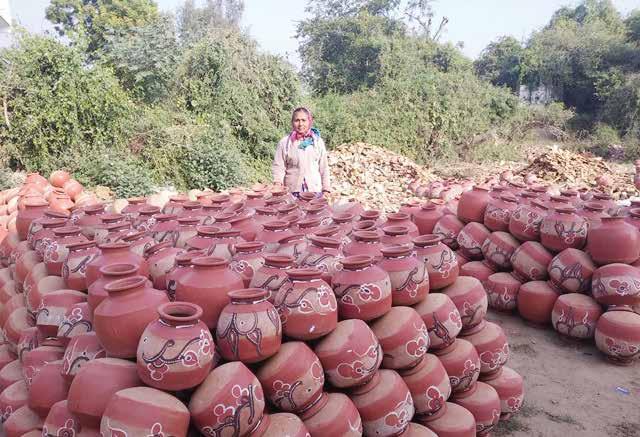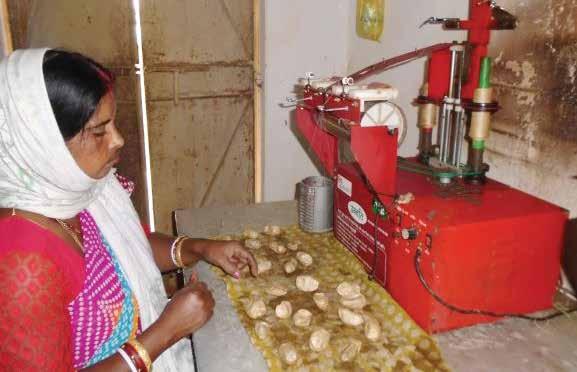
5 minute read
TABLE 4: Electricity bills of powerloom units
operate for 10 hours every day, with smaller units producing up to 100–150 articles, medium units producing up to 200–300 articles, and larger units producing around 500–600 articles a day. The monthly production capacity also varies depending on the demand and the size of the enterprise. Each unit generates monthly revenue in the range of INR 30,000 to INR 1.5 lakh per month based on their level of productions.
Production process
Advertisement
Wood from Hale Mara tree, also known as ivory wood or soft wood, is cut into small-sized chunks or billets, and kept aside for ‘seasoning’ to remove moisture. The seasoned wood is again cut into small pieces of required length by a cutter, which is further shaped by a ‘Lathe’, a mechanical device used for rotating wood using chisels. The toys are coloured using lac. A lac stick of a chosen colour is pressed onto the rotating wood; due to friction, the lac melts and gets coated on the wood surface. A dried palm leaf is used to spread the applied lac uniformly over the surface and rendering the product a lustrous appearance.
Energy consumption
A lathe machine, circular cutters or band saws, and drilling machines are some of the motorized equipment used in toy production in this region, which are run for around 10 hours a day. The cumulative energy consumption of the motors is 2 HP, 6.5 HP, and 10 HP for small, medium and big units, respectively. There is no reported shortage of grid electricity, barring rare short outages. The average monthly electricity bill has been checked for all different units and the details have been provided in Table 4. Like in other clusters, entrepreneurs in Channapatna are interested to explore the option of solar to power their production activities and are willing to contribute 20–30% of the system cost from their end.
Design of solar PV
For this cluster, TERI proposes grid-connected solar systems (without battery back-up) for small, medium, and large capacity units of toy making that will power the machineries for woodworking. The design of the system has been done considering space constraint and investment capacity of the studied cluster. Thus, it has been assumed that 50% of the energy will be met through solar and the balance 50% will be met through the grid.
In the small unit, a grid-fed individual solar PV system with capacity of 3 kWp, in medium units, a grid-fed individual solar PV system with capacity of 6 kWp, whereas in the large unit, a grid-fed individual solar PV system with capacity of 14 kW will be required to meet the power needs. The area requirements for the installation of solar PV systems in the small medium, and large plants are 20 m2, 40 m2 , and 95 m2, and the systems’ costs (calculated using MNRE benchmark prices – INR 54 per Wp and INR 48 per Wp) would be INR 162,000, INR 324,000, and INR 672,000, respectively.
Proposed business model
For this study, the micro-enterprise units in Ramnagara–Channapatna wooden toy cluster have been segregated into three categories (small: 3 kWp system, medium-6 kWp system, and
TABLE 4: Electricity bills of powerloom units Categorization of power loom unit Average monthly electricity expenses (INR) Large (up to 6 lathe/unit) 11,000 to 11,500 Medium (up to 4 lathe/unit) 5000 to 5500 Small (up to 2 lathe/unit) 2000 to 2500
large-14 kWp system) depending upon the size of the solar PV system required to meet their power needs. For each of the three categories, with a mix of 20% equity, 65% capital subsidy on hardware, and a 5 years bank loan of the remaining 15% amount, the payback can be brought down to less than 6 years. It is evident that even after reducing the rate of interest on bank loan from 12% to 8% per annum, the payback does not drastically change. Out of the required subsidy component, 10% can be leveraged6 through the DIC. The remaining subsidy amount will have to be leveraged through Karnataka State Handicrafts Development Corporation (Cauvery Handicrafts), CSR funds, and philanthropic institutions.
Solar potential of the cluster
Solar potential has been estimated for business interest of solar manufacturer and suppliers which may further enhance the viability. There are approximately 500 units which include around 300 small units, 100 medium units, and 100 large units. If all the units are solarized, the cluster can provide solar PV potential of around 1000 kWp7 .
Solar potential assessment across the clusters in Karnataka
The cumulative solar potential across all the studied clusters in the state was assessed and has been provided in Table 5. This information would be relevant for the solar suppliers or developers at the state or national level who might assess their business potential if they intervene in the identified clusters.
4.2 Gujarat
Gujarat is one of the most progressive and prosperous states in India, renowned for being the hub of industrial development and having a business- and investor-friendly environment. Enterprises, be it large industries or small units, have found space to progress in Gujarat. The state provides upgraded infrastructure, credit, technology, etc. to support its vibrant industrial ecosystem.8 With more than 3.3 million MSMEs, Gujarat features among the top 10 states for MSMEs in India, with a share of 5% of the total. The microenterprises form the major chunk of MSMEs with more than 3.2 million enterprises, according to the 73rd round of the NSS. The total number of workers engaged in the MSME sector exceeds 6.1 million (Ministry of MSME 2019). The state has formulated a range of policies for fostering the development of MSMEs. The Gujarat Industrial Policy 2015 has provisions related to the use of non-conventional energy for MSMEs. For example, capital investment subsidy of 20% on a term loan and 7% interest subvention for MSMEs are mentioned in the policy.9 Additionally, there is a provision for supporting energy-efficiency measures by subsidizing 25% of the cost of equipment. The RURBAN approach mentioned in the policy encourages sustainable business models that make use of non-conventional energy sources including solar technology. The policy also mandates research
6 Details available at https://kum.karnataka.gov.in/KUM/PDFS/Operative%20Guidelines%20for%20DIC%20KARNATAKA%20
INDUSTRIAL%20POLICY%202014-19.pdf 7 The solar potential for the cluster has been calculated as: (capacity of solar system as per proposed solar design) × (total number of units in the cluster) 8 Details available at https://gujaratindia.gov.in/business/investment-destination.htm, last accessed on June 23, 2020 9 Details available at https://ic.gujarat.gov.in/documents/pagecontent/revised-GR-01-04-2017-08112017.pdf, last accessed on
June 23, 2020




